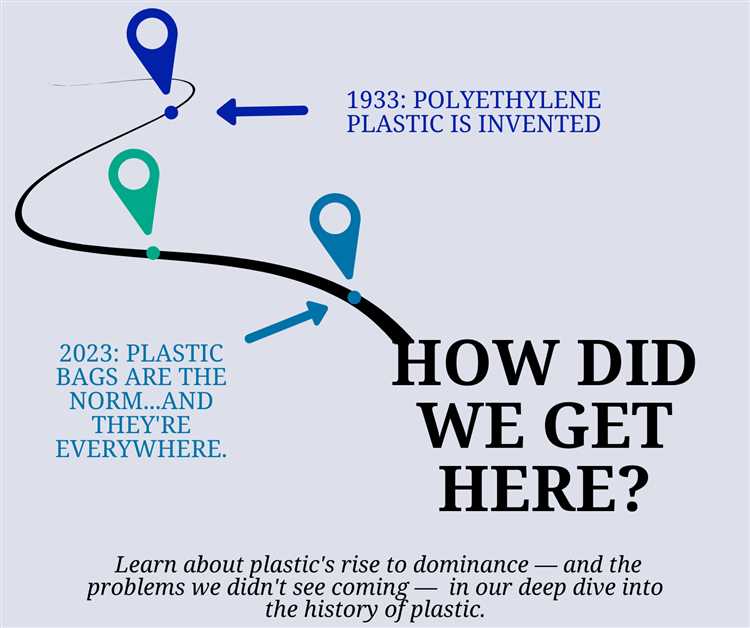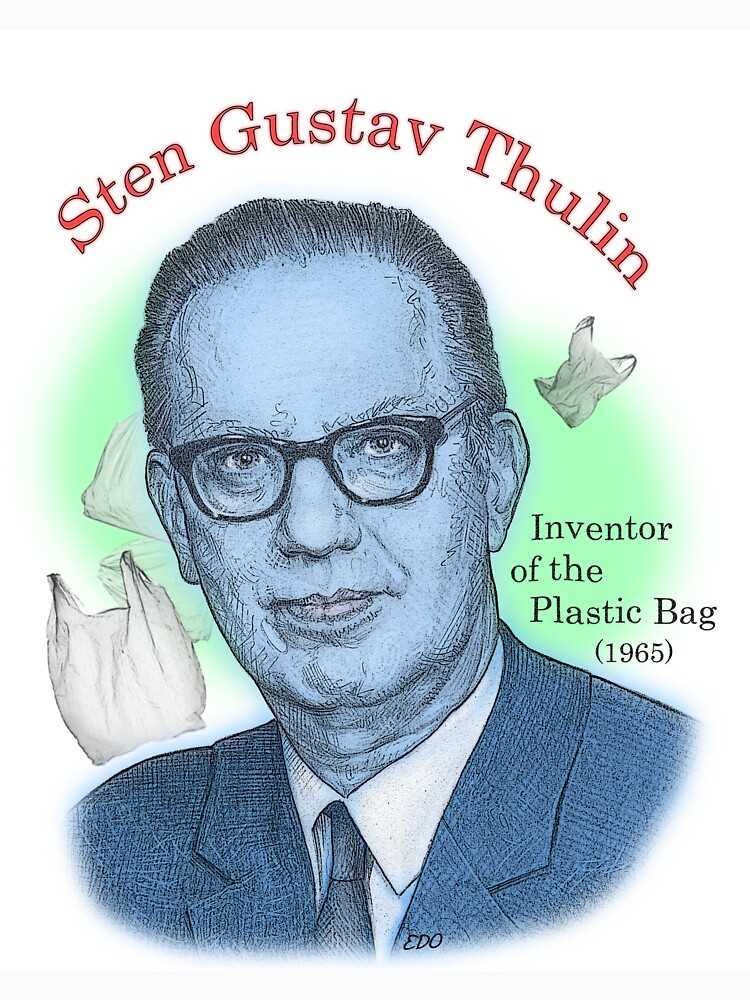
Plastic bags have become an indispensable part of our daily lives. From carrying groceries to storing items, they are widely used for their convenience and versatility. However, have you ever wondered who was behind the invention of this revolutionary product?
The inventor of the plastic bag is Swedish engineer Sten Gustaf Thulin. In the early 1960s, Thulin was working for the Swedish packaging company Celloplast when he came up with the idea of creating a more practical and efficient bag. His invention was a result of experimentation with different materials and designs, eventually leading to the introduction of the plastic bag as we know it today.
Thulin’s innovation revolutionized the way we carry and store items. Unlike traditional paper bags, plastic bags are lightweight, durable, and water-resistant, making them ideal for various purposes. Their widespread adoption and affordability quickly made them a popular choice around the world, leading to their immense popularity.
Although plastic bags have received criticism in recent years for their environmental impact, it is important to recognize the inventiveness behind their creation. Thulin’s invention has had a lasting impact on modern society, shaping consumer habits and providing a convenient solution for everyday needs.
- Meet the Genius
- From Humble Beginnings
- The Impact of Thulin’s Invention
- A Lasting Legacy
- Inspiration Strikes
- Revolutionizing the Packaging Industry
- An Enduring Legacy
- The Invention is Born
- Revolutionizing the Industry
- Environmental Impact
- The Future of Packaging
- Legacy and Impact
- Questions and answers:
- Who invented the plastic bag?
- What inspired Sten Gustaf Thulin to invent the plastic bag?
- How did the invention of the plastic bag revolutionize the retail industry?
- What are some of the environmental concerns associated with the use of plastic bags?
- Are there any alternatives to plastic bags?
Meet the Genius

Behind the revolutionary invention of the plastic bag is an innovative genius by the name of Sten Gustaf Thulin. Born in Sweden in 1931, Thulin dedicated his life to finding efficient and sustainable solutions to everyday problems.
Thulin’s breakthrough came in the early 1960s when he was working as an engineer for the Swedish packaging company Celloplast. Frustrated by the lack of practical and eco-friendly alternatives to paper bags, he set out to create a lightweight, durable, and affordable option that could transform the way we carry and store items.
After extensive experimentation, Thulin successfully developed the polyethylene plastic bag, which quickly gained popularity for its versatility and convenience. His invention revolutionized the packaging industry and became the foundation for the modern plastic bag we use today.
Thulin’s genius extended beyond the realm of plastic bags. Throughout his career, he filed more than 100 patents for various innovative products, including packaging solutions, adhesive formulas, and even a design for a folding ping-pong table.
Despite the widespread criticism and debates surrounding plastic bags’ environmental impact, it is important to recognize the genius behind their invention. Thulin’s ingenuity and commitment to finding sustainable solutions have left an indelible mark on our daily lives and serve as a testament to the power of human innovation.
In conclusion, Sten Gustaf Thulin is the genius behind the plastic bag innovation. His dedication, creativity, and problem-solving skills have changed the way we carry and store items, and his contributions to the field of packaging continue to inspire new generations of inventors.
From Humble Beginnings
The inventor of the plastic bag, Sten Gustaf Thulin, hailed from Sweden and had a passion for creating innovative solutions to everyday problems. Born on March 29, 1915, in Kalmar, Sweden, Thulin was fascinated by engineering from a young age. After completing his education in mechanical engineering, he started working at Celloplast, a packaging company known for its groundbreaking inventions.
In the early 1960s, Thulin was tasked with finding a more efficient and cost-effective alternative to paper bags. At the time, paper bags were heavy, took up a significant amount of storage space, and were not suitable for packaging all types of goods. Thulin saw an opportunity to revolutionize the packaging industry and set out to find a solution.
After months of experimentation and testing, Thulin developed the world’s first plastic bag with a simple yet effective design. The bag was made from a thin, durable, and waterproof material called polyethylene. Its lightweight nature made it easy to carry and store, while its affordability made it accessible to a wide range of businesses and consumers.
The Impact of Thulin’s Invention
Thulin’s plastic bag quickly gained popularity in Sweden and soon spread to other parts of Europe. Its versatility and convenience made it a preferred choice for various industries, including retail, food, and healthcare. The plastic bag provided a hygienic solution for packaging perishable items, offering protection against moisture and contaminants.
However, as the use of plastic bags became more widespread, concerns about their environmental impact arose. Plastic bags were found to contribute to pollution, waste, and harm to wildlife. In response, various sustainability initiatives and regulations were implemented to reduce the use of single-use plastic bags and encourage recycling.
A Lasting Legacy
Despite the challenges posed by plastic bag waste, Sten Gustaf Thulin’s invention remains a significant milestone in packaging history. His innovative solution revolutionized the industry, offering an affordable and convenient packaging option for businesses and consumers worldwide. Today, efforts are being made to develop sustainable alternatives that retain the convenience of Thulin’s plastic bag while minimizing its environmental impact.
| Year | Event |
|---|---|
| 1960s | Sten Gustaf Thulin develops the world’s first plastic bag |
| 1970s | Plastic bags gain popularity in Europe |
| 2000s | Concerns about plastic bag waste lead to sustainability initiatives |
Inspiration Strikes

For many inventors, inspiration strikes at the most unexpected moments. This was certainly true for Swedish engineer Sten Gustaf Thulin, who came up with the idea for the plastic bag while on a flight in the early 1960s.
During the flight, Thulin observed how the thin, light-weight plastic used for inflight food packaging was able to hold up to the pressure and contain its contents without tearing. This observation sparked an idea in Thulin’s mind – what if this type of plastic could be used to create a lightweight, durable, and waterproof bag?
After landing, Thulin immediately set to work on his idea and began experimenting with different types of plastic materials and production methods. His goal was to create a bag that was not only strong and practical but also easy and cost-effective to produce.
Thulin’s hard work paid off, and by 1965, he had successfully developed the first version of the plastic bag that we know today. His invention quickly gained popularity due to its convenience and versatility.
Revolutionizing the Packaging Industry
Thulin’s innovative plastic bag soon caught the attention of packaging companies around the world. They recognized its potential to revolutionize the way products were packaged and sold.
One of the main advantages of Thulin’s plastic bag was its ability to be mass-produced at a relatively low cost. This made it an attractive option for both manufacturers and consumers, as it allowed for greater efficiency and lower prices.
Furthermore, the plastic bag’s durability and resistance to water made it ideal for storing and transporting a wide range of products. Its lightweight nature also meant that it was easy to carry and handle.
An Enduring Legacy
Today, the plastic bag is one of the most widely used and recognized packaging solutions across the globe. It has become an essential part of our daily lives, used for everything from carrying groceries to storing household items.
Thulin’s invention has undoubtedly had a lasting impact on the packaging industry and has paved the way for future advancements in materials and design. His innovative thinking and dedication to creating a practical solution have left a lasting legacy.
In conclusion, inspiration can strike at any time, even on a routine flight. Sten Gustaf Thulin’s observation and creative thinking led to the development of the plastic bag, an invention that has transformed the way products are packaged and sold. His legacy serves as a reminder of the power of innovation and the potential for everyday objects to make a significant impact.
The Invention is Born
In the early 1950s, a Swedish engineer named Sten Gustaf Thulin was working at the packaging company Celloplast. It was during this time that Thulin developed the idea for a simple and practical solution to the problem of carrying items without them getting wet or dirty.
Thulin’s invention consisted of a thin, water-resistant plastic bag with handles, which he called the “plastic bag with handles.” This innovative design made it easier for people to carry their groceries, books, and other items, without the need for bulky and inconvenient packaging.
Thulin’s plastic bag with handles was an instant success, as it provided a convenient and hygienic alternative to traditional paper bags. The invention quickly gained popularity in Sweden, and soon, other countries around the world began to adopt the plastic bag with handles as well.
The plastic bag with handles revolutionized the way people shopped and transported their belongings. It made carrying heavy items much easier and more comfortable, and it also helped reduce waste by providing a reusable and long-lasting option for carrying goods.
Thulin’s invention had a significant impact on the packaging industry, and it paved the way for the development of other plastic bag variations, such as the ziplock bag and the vacuum-sealed bag. Today, plastic bags with handles are widely used and have become an essential part of our daily lives.
Although Thulin’s invention was a major success, he did not patent it, as he believed that it should be available for everyone to benefit from. His selflessness and vision have made the plastic bag with handles one of the most iconic and influential inventions in modern history.
Revolutionizing the Industry
With the invention of the plastic bag, a revolution began in the industry. This simple yet innovative creation changed the way goods were packaged and transported, making it more convenient for both businesses and consumers alike.
The plastic bag provided a lightweight and durable alternative to traditional paper bags, which were often bulky and easily torn. Its water-resistant properties made it ideal for storing and transporting a wide range of products, from groceries to clothing.
Not only did the plastic bag offer practical benefits, but it also revolutionized the advertising industry. Businesses quickly realized the marketing potential of this ubiquitous item and began printing their logos and slogans on the bags.
This advertising technique proved to be highly effective, as plastic bags with logos became mobile billboards that reached a wide audience. The visibility and reach of these bags made them a valuable tool for brand promotion, boosting the success of businesses across various industries.
Environmental Impact
Although the plastic bag revolutionized the industry, its widespread use has also raised concerns about its environmental impact. The durability and non-biodegradable nature of plastic have led to accumulation in landfills and pollution in oceans and waterways.
Recognizing these issues, efforts have been made to reduce the environmental impact of plastic bags. Many countries have implemented regulations and policies to encourage the use of reusable bags and promote recycling. Additionally, alternatives such as biodegradable and compostable bags have been introduced to lessen the impact on the environment.
The Future of Packaging
The plastic bag revolution may have brought convenience and marketing opportunities, but its impact on the environment has prompted the need for more sustainable packaging solutions. As the industry continues to evolve, innovations in materials and technologies are being developed to address these challenges.
Research and development in bio-based materials, compostable packaging, and recycling technologies are paving the way for a more sustainable future. The goal is to revolutionize the industry once again, this time with packaging solutions that balance convenience and functionality with environmental responsibility.
The plastic bag was just the beginning of a revolution that continues to drive change in the packaging industry. With innovative ideas and a commitment to sustainability, the future of packaging holds great potential for new advancements that will benefit both businesses and the environment.
Legacy and Impact
The invention of the plastic bag has had a significant impact on our daily lives and the environment. Despite its convenience and widespread use, plastic bags have become a notorious symbol of waste and pollution. However, it is essential to recognize the positive aspects of this invention and the lasting legacy it has left behind.
One of the most significant contributions of the plastic bag is its role in revolutionizing the retail industry. Before the invention of plastic bags, consumers relied on paper or cloth bags, which were bulkier and less durable. Plastic bags, with their lightweight and sturdy design, provided a cost-effective solution for both retailers and consumers. They allowed for easier transportation of goods, improved efficiency at checkout lines, and reduced the need for packaging materials, ultimately making the shopping experience more convenient for everyone.
Moreover, the invention of plastic bags has played a vital role in the global economy. Plastic bag manufacturing has created millions of jobs worldwide, from the production of raw materials to the assembly and distribution processes. This industry has sustained the livelihoods of numerous individuals and contributed to economic growth in many countries.
However, it is crucial to acknowledge the environmental concerns associated with plastic bags. The durability and resistance to decomposition that make them so convenient also make them a significant source of pollution. Plastic bags are not biodegradable and can persist in the environment for hundreds of years. They are often discarded improperly and can end up in rivers, oceans, and landfills, posing a severe threat to wildlife and ecosystems.
Nevertheless, there have been significant efforts to mitigate the environmental impact of plastic bags. Many countries and cities have introduced legislation to reduce their usage or ban them outright. Additionally, the invention of biodegradable and compostable plastic bags provides a potential solution to the pollution problem. These bags are designed to break down more quickly in natural environments, reducing their harm to the planet.
| Positive Aspects | Negative Aspects |
|---|---|
| Revolutionized retail industry | Environmental pollution |
| Cost-effective and convenient | Improper disposal and waste |
| Created jobs and contributed to the economy | Long-lasting and non-biodegradable |
| Potential for biodegradable alternatives | Threat to wildlife and ecosystems |
In conclusion, the invention of the plastic bag has had a complex legacy with both positive and negative impacts. While it has undoubtedly improved convenience and efficiency in various industries, it has also contributed significantly to environmental pollution. It is crucial for individuals, industries, and governments to recognize these challenges and work towards sustainable alternatives, ensuring a brighter future for our planet.
Questions and answers:
Who invented the plastic bag?
The plastic bag was invented by a Swedish engineer named Sten Gustaf Thulin in the early 1960s.
What inspired Sten Gustaf Thulin to invent the plastic bag?
Sten Gustaf Thulin was inspired to invent the plastic bag after observing the popularity of plastic food packaging and realizing the need for a convenient, lightweight and durable alternative to paper bags.
How did the invention of the plastic bag revolutionize the retail industry?
The invention of the plastic bag revolutionized the retail industry by providing a cost-effective, convenient and hygienic packaging solution for goods. It allowed for easier transportation of products, reduced the need for paper bags, and became a standard packaging option for retail businesses around the world.
What are some of the environmental concerns associated with the use of plastic bags?
The use of plastic bags has raised several environmental concerns. They are not biodegradable and can take hundreds of years to decompose, leading to an accumulation of plastic waste in landfills and oceans. Plastic bags can also be harmful to wildlife, as animals may mistake them for food and ingest them, leading to injury or death.
Are there any alternatives to plastic bags?
Yes, there are several alternatives to plastic bags. Some popular options include reusable cotton or canvas bags, paper bags, and biodegradable bags made from materials such as cornstarch or vegetable oil. These alternatives are more environmentally-friendly and can help reduce plastic waste.